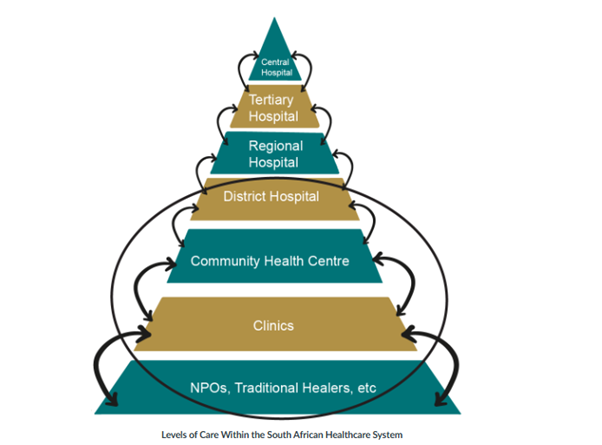Week 6 - Service Delivery
Session 1 - Levels of Care
- Spark Questions
- Session summary and reflection
- Learning Outcome
- Concluding Questions: Defining Health & Health Systems Sciences
Spark Questions
When Accessing healthcare, what things do you consider when choosing to use a health care service
Firstly, I consider if I actually need care. I ask question such as :
- Whats the problem?
- Am I able to fix the issue on my own?
- Do I require care?
- I will then check what help I need
- Check if it is Affordable
- Check if the quailty of care is good
Session summary and reflection
Healthcare services are structured across different levels to improve efficiency and allocate resources effectively. Primary care serves as the first point of entry, offering community-based services such as clinics and health centers. When specialized care is needed, patients are referred to secondary care facilities, like district and referral hospitals, staffed by specialized healthcare providers. For complex or severe cases, tertiary and quaternary facilities provide advanced, super-specialized care, often at higher costs due to the required technologies and expertise. Support services, like the National Health Laboratory Service (NHLS), aid all levels, ensuring comprehensive patient care across the system.

Primary Level of Care: The first point of contact for individuals seeking health services. It often includes community-based services, primary health care clinics, private GP practices, and community health centers. Workers here include community health workers, pharmacists, nurses, clinical associates, and family physicians.
Secondary Level of Care: Focuses on specialist care often in hospitals. Patients are referred here when they require specialized medical attention, such as a pregnant woman needing a C-section at a district or regional hospital.
Tertiary Level of Care: Reserved for severe or complex cases that require advanced technology and specialized teams, typically found in larger hospitals. Central hospitals at this level, like Charlotte Maxeke and Chris Hani Baragwanath in South Africa, also serve as training grounds for medical students and specialists.
Each level serves distinct roles, creating a structured pathway for patient care from initial contact to specialized treatment.
Learning outcome - Levels of Care
- Describe the different levels of care in the delivery of health services.
- Primary Care: Community-based entry level, including clinics and health centers, focused on basic health needs.
- Secondary Care: District and referral hospitals providing specialized services when primary care isn’t sufficient.
- Tertiary and Quaternary Care: Advanced, super-specialist care for complex cases in large hospitals with specific technologies and expertise.
- Explain how each level of care relates to one another in terms of how provincial health care services are organised
- Each level serves as a step-up from the previous, referring patients to higher levels as needed for specialized treatment. This organized structure within provincial health services helps manage patient flow and resource allocation effectively, ensuring that each level has the appropriate facilities and personnel to address varying healthcare needs.
Conclusion questions: Service Delivery
- When accessing healthcare, what things do you consider when choosing to use a health care service?
- Accessibility
- Affordability.
- Quality of Care:
- Availability of Services
- Personal Comfort
- What are the different levels of care within the health service?
- Primary Care: First point of contact; includes community-based services such as clinics and general practitioners for basic health needs.
- Secondary Care: Provided at district and referral hospitals for patients needing specialist attention.
- Tertiary Care: Advanced care in specialized hospitals equipped with high-end technology and experts for complex cases.
- Quaternary Care: Highly specialized, often national-level services, involving advanced technology and highly trained professionals for rare, complex cases.
- What are the challenges with referral between the different levels of care?
- Communication Issues: Incomplete or unclear referral letters can lead to delays and inappropriate care.
- Access Barriers: Transportation delays, especially in rural areas, hinder timely patient transfers.
- Resource Limitations: Primary care facilities may be overcrowded or under-resourced, slowing the referral process.
- Long Waiting Times: High demand for specialized services often leads to long queues at higher levels of care.
- Cost: Some patients cannot afford referrals to private or distant facilities, limiting their access to necessary care.
- Logistics and Infrastructure: Coordination challenges with emergency services and accommodation for long-distance non-urgent cases add complexity to the system.